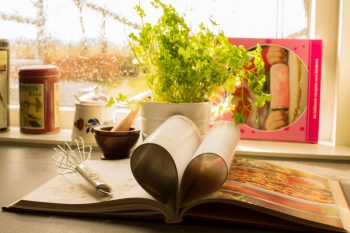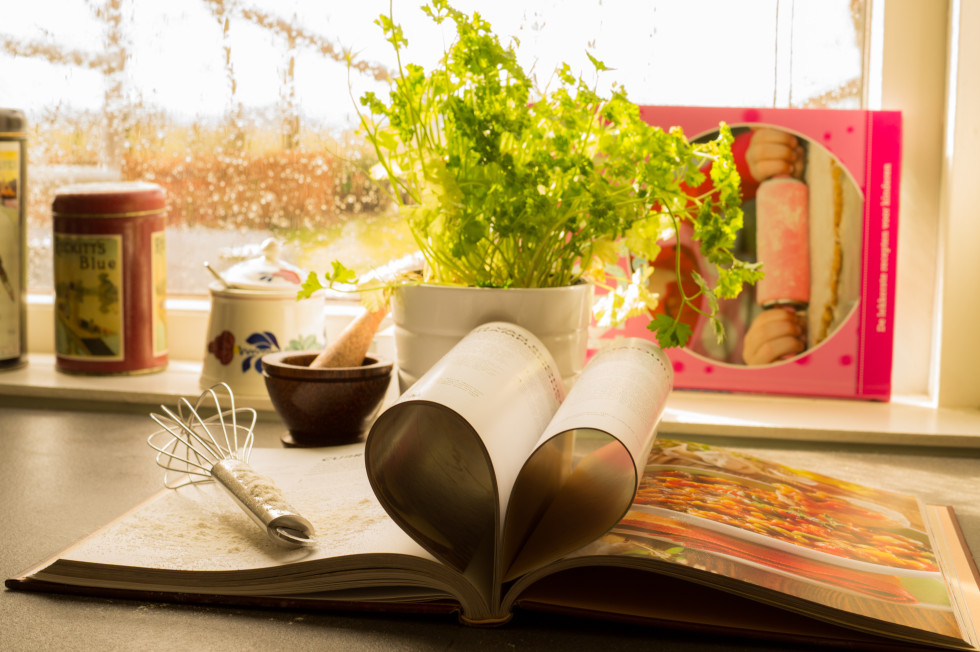
I grew up in a home with two Southern cooks. My grandmother lived with us for most of my childhood, and since she was raised on a small farm in central Kentucky, I was fortunate enough to eat authentic Kentucky Fried Chicken from the time I was old enough to chew. Not to mention angel biscuits, southern fried okra, homemade fruit and cream pies, and – the piece de resistance in my mind – her warm, yeasty bread with its crisp buttery crust. Paired with a platter of garden fresh tomatoes, warm slow-cooked green beans, and a glass of iced tea, we feasted for many a summer lunch.
 My mother insisted she could not cook as well as her own mother did, but most of us begged to differ. My mom’s specialties weren’t the country cooking my grandmother learned in the farm kitchen. My mom excelled at dishes with a slightly international flair -like spaghetti and lasagna, Swedish meatballs, quiche lorraine. She was the chief cake baker in the family, and her German chocolate cake with caramel frosting was the most requested dessert at every family potluck.
My mother insisted she could not cook as well as her own mother did, but most of us begged to differ. My mom’s specialties weren’t the country cooking my grandmother learned in the farm kitchen. My mom excelled at dishes with a slightly international flair -like spaghetti and lasagna, Swedish meatballs, quiche lorraine. She was the chief cake baker in the family, and her German chocolate cake with caramel frosting was the most requested dessert at every family potluck.
Last winter, when we knew my mother was dying, it occurred to us just how many of our favorite foods we’d never taste again. My husband and I would be sitting at the table, picking at our food between trips to the hospital. “Cheese cake,” I said once. “We’ll never have her cheese cake again.”
“Or beef pot pies,” he said dejectedly. “Or baked spaghetti.”
“Potato salad,” I yelped.
“Ohhhh,” he groaned.
Should this sound less than respectful toward my mother’s final days, rest assured there is little she would rather be remembered for. She considered her cooking one of her proudest accomplishments, one the world recognized and rewarded. One year her neighbors gifted her with pearl handled cake server, engraved with her name and the words “Redford’s Best Baker.” She prized that just as much as her diamond rings and full length mink coat.
One of my projects this summer has been an attempt to replicate some of my mother’s most popular recipes. I’m really not the cook my mother was (and no one in my family would beg to differ on that assertion), so it’s been a daunting task, and one I’ve met with varying degrees of success.
There’s an old saying: If you can read, you can cook. Meaning, if you can follow the recipe, you can expect an edible finished product. I’m here to tell you, that’s not quite so. I’ve followed my mother’s spaghetti sauce recipe to the letter, and it still doesn’t taste exactly right. And while many people have attempted the caramel frosting, no one has ever made it successfully. She was often accused of sabotaging the recipe, which she always denied. “It takes time and patience to get that right,” she’d say with a little smile. “Just keep practicing.”
Often there is a secret ingredient to the best dishes, one that you don’t find listed in the lines of the recipe. Part of it’s the kind of wisdom we gain by watching someone work, and I will always regret not spending more time in the kitchen with my mother, soaking up some of her knowledge about bringing a recipe to life.
But more than that, there is a certain creative something only a few people possess, and it’s not something you can study or read or even be taught. In my handbell ensemble we talk about this very quality – in fact, it’s our (legal!) trademark. “Ringing in Color,” we call it, and it means taking the black and white notes of music and bringing them into vivid color with various creative touches – dynamic changes, movement, the particular lift of a musical line. Thus the finished product is made up of more than just following the music notes on the staff, more than just putting the ingredients in the recipe in a bowl and stirring them up.
My mother had that special quality, and she seasoned her cooking with it as well as the rest of our home. She was the kind who could arrange a vase of flowers just so, wrap a package so beautifully no one wanted to undo it, place a picture on the perfect wall to show it off to its best advantage. She knew exactly how to put things together – from clothes to jewelry to home furnishings – so it looked stylish and elegant. If I were to suggest that she was being “creative,” she would laugh. “That’s nothing,” she’s say. “You’re the creative one with your book writing and your music.”
I believe each one of us has a unique creative gift, an ability to bring an extra touch of beauty to life. Yours might be in painting or sculpture, writing or music, sewing or crafting, cooking or gardening. Discovering that individual gift is one of life’s great adventures, and why it’s important of offer children the opportunity to participate in all kinds of activities. We learn by doing, by putting our hand to something, by feeling our way through the black and white instructions and uncovering our inherent ability to add the “color” that makes it come alive.
I nearly wept for joy the first time I made potato salad and it tasted exactly like my mother’s. I wonder if it’s because there was no written recipe, and I had to go purely on instinct and “feel.” Sometimes we can become so caught up in those black and white instructions we forget to trust our own creative instincts. So I’ll keep working on the spaghetti sauce. Maybe I should trust my inner wisdom and stop trying to follow the recipe so exactly.
If I’m really lucky, I may discover that I’ve inherited some of that kitchen creativity after all.
About the Author: Becca Rowan
 Becca Rowan lives in Northville, Michigan with her husband and their two dogs. She is the author of Life in General, a book of personal and inspirational essays about the ways women navigate the passage into midlife. She is also a musician, and performs as a pianist and as a member of Classical Bells, a professional handbell ensemble. If she’s not writing or playing music you’ll likely find her out walking with the dogs or curled up on the couch reading with a cup of coffee (or glass of wine) close at hand. She loves to connect with readers at her blog, or on Facebook, Twitter, or Goodreads.
Becca Rowan lives in Northville, Michigan with her husband and their two dogs. She is the author of Life in General, a book of personal and inspirational essays about the ways women navigate the passage into midlife. She is also a musician, and performs as a pianist and as a member of Classical Bells, a professional handbell ensemble. If she’s not writing or playing music you’ll likely find her out walking with the dogs or curled up on the couch reading with a cup of coffee (or glass of wine) close at hand. She loves to connect with readers at her blog, or on Facebook, Twitter, or Goodreads.

